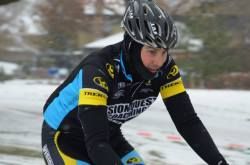The leaves have fallen, the days have shortened. It’s time to face facts: we’re in the throes of winter.
Cyclists especially may experience a bit of dread at the thought of climbing back onto the CompuTrainers. Triathletes could be a little better off since runs and swims are less affected by weather and light, but they still might question how they’re going to deal with their cycling workouts. By incorporating a few tricks into the winter routine, all athletes should be able to continue training effectively through the colder months and come into the spring season ahead of the game.
One of the most important and often neglected components of endurance performance is movement efficiency. Being the most powerful athlete in a race won’t get you anywhere unless you are able to effectively translate that power to forward speed. The repetitive nature and single-plane movements of endurance sports tend to lead to overuse injuries and lateral muscle weakness and instability. Including two or three weekly functional training classes in your program will help to increase overall strength, allowing your muscles to produce more force, but these classes will also improve core stability and flexibility so that force can be transferred more effectively. Cross-training can be another valuable tool in the winter training repertoire. Including a more diverse range of movements and exercises through new sports promotes increased balance throughout the body to combat the weakness and instability that results from heavy endurance training. Different sports can fill different roles as well. Pick-up basketball or soccer games can serve as informal interval workouts. Cross country skiing and long hikes help to develop the aerobic system. Although the muscles recognize the difference between sports and movements, the cardiovascular system sees all exercise the same way.
Finishing a cross-training workout with 30 to 60 minutes of easy spinning will even help to promote muscle memory on the bike, making the workout more effective. With cycling volume tapering off into the winter months, this is a prime opportunity for triathletes to dedicate some time and effort to improving their weaker sports. Swimming more frequently will develop a stronger base and provide the repetition needed to get a strong feel for an efficient pull. Working several short, easy runs at conversational pace into the weekly routine will develop durability in soft tissues so that runners will be better prepared for longer runs later in the season. Like swimming, this is also a good time to make adjustments to running technique. For those who have a higher tolerance for cold and muck, cyclocross offers a perfect opportunity to extend the cycling season. The workouts are often short and intense, meaning the body will generate a lot of heat without having to endure hours in the cold. Riding speed is reduced relative to road riding, so wind chill is less of a factor. Cyclocross racing has grown tremendously in popularity, so it shouldn’t be too hard to find a race nearby for those still hankering for competition.
Finally, we come to the CompuTrainer: the bane of many a cyclist’s or triathlete’s winter training regimen. The key to maintaining your sanity is going into each workout with a specific goal. On the trainer, you never stop pedaling so the benefit you get out of the time you spend riding will be somewhat higher than it is on the road. The controlled nature of indoor training lends itself to more structured workouts and intervals that would be difficult to pull off outside. Single-legged pedaling drills can be safely and easily incorporated into the workout as well. Training with others and having music to listen to or movies to watch also makes the time pass faster, especially on the long rides.
As you can see, the winter does not have to be a time to take a step back from your training. Although it is certainly worthwhile to take a bit of a mental and physical break from training, Midwest winters are long enough that you can’t afford to take the whole winter off. Including new sports or shifting your focus to other aspects of your event-specific sport can quickly fill your time so that you don’t have to endure hour upon hour on the trainer. This way, when the weather finally starts to warm up in the spring, you’ll still be excited to get out for that first long, sunny ride.

